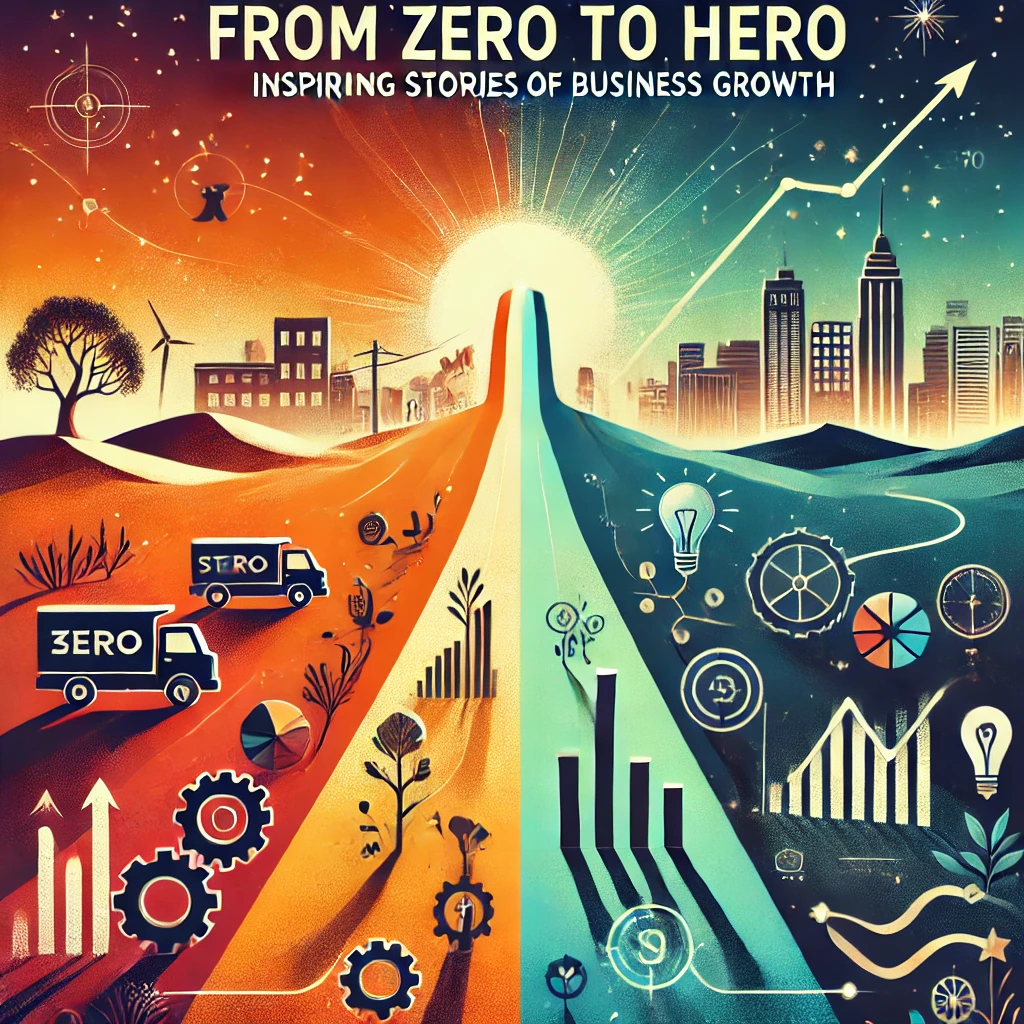
From Zero to Hero: Inspiring Stories of Business Growth
Introduction

The journey of an entrepreneur is often filled with challenges, risks, and a relentless pursuit of success. Every business has a story—some begin with a big idea and modest resources, while others start with nothing but a dream and determination. In this article, we’ll explore 15 detailed case studies of businesses that rose from humble beginnings to exceptional success. These stories will inspire aspiring entrepreneurs and provide actionable lessons for anyone looking to start or grow their business.
Case Study 1: Sara Blakely – Spanx

The Story:
Sara Blakely started Spanx with just $5,000 in savings and no background in fashion or business. Frustrated by the lack of comfortable undergarments, she designed footless pantyhose that would fit better and look seamless under clothes.
How She Succeeded:
Blakely developed her product and marketed it creatively, often pitching directly to department stores. Oprah Winfrey’s endorsement of Spanx catapulted the brand into the spotlight. Today, Spanx is a billion-dollar company.
Key Lessons:
- Identify a problem you deeply understand.
- Leverage creative marketing and word-of-mouth endorsements.
- Persistence is crucial when starting from scratch.
Case Study 2: Howard Schultz – Starbucks

The Story:
Howard Schultz transformed Starbucks from a small Seattle-based coffee bean store into a global coffeehouse empire. Schultz envisioned Starbucks as a “third place” between home and work where people could connect.
How He Succeeded:
By focusing on customer experience, premium-quality coffee, and an inviting atmosphere, Schultz expanded Starbucks globally. He also innovated with loyalty programs and digital services.
Key Lessons:
- Focus on customer experience to build loyalty.
- Innovate and adapt to changing customer needs.
- A strong vision can guide long-term success.
Case Study 3: Daymond John – FUBU

The Story:
Daymond John started FUBU (For Us By Us) in his mother’s house with $40. He hand-sewed clothing targeting the urban and hip-hop communities, a market that was largely ignored at the time.
How He Succeeded:
John used guerrilla marketing, including having celebrities wear his designs, to build brand recognition. The brand eventually grew into a $6 billion company.
Key Lessons:
- Grassroots marketing can create significant impact.
- Start small and scale strategically.
- Know your audience and cater specifically to them.
Case Study 4: Elon Musk – Tesla

The Story:
Elon Musk joined Tesla Motors when it was struggling financially. He envisioned a future where electric cars would replace traditional vehicles, making transportation more sustainable.
How He Succeeded:
Musk invested heavily in R&D and manufacturing, focusing on quality and innovation. He also used Tesla’s mission to attract investors and customers who aligned with the company’s vision.
Key Lessons:
- Think big and solve global problems.
- Don’t shy away from risks if you believe in your mission.
- Innovation and sustainability can drive growth.
Case Study 5: Jan Koum – WhatsApp

The Story:
Jan Koum, a Ukrainian immigrant, started WhatsApp as a simple messaging app that was ad-free and easy to use. His vision was to create a reliable communication tool.
How He Succeeded:
By focusing on user experience, Koum grew WhatsApp organically, attracting millions of users worldwide. Facebook eventually acquired WhatsApp for $19 billion.
Key Lessons:
- Simplicity and reliability attract loyal users.
- Focus on solving a specific problem effectively.
- Organic growth can be more sustainable than aggressive advertising.
Case Study 6: Jeff Bezos – Amazon
The Story:
Jeff Bezos founded Amazon as an online bookstore in 1994. Despite fierce competition, he envisioned a platform where customers could buy anything online.
How He Succeeded:
Bezos reinvested profits into expansion, focusing on logistics and customer satisfaction. Today, Amazon is a global e-commerce leader.
Key Lessons:
- Customer obsession drives long-term success.
- Reinvent your business model as opportunities evolve.
- Scale strategically to dominate your market.
Case Study 7: Rihanna – Fenty Beauty
The Story:
Rihanna launched Fenty Beauty in 2017, offering inclusive beauty products for all skin tones. She noticed a gap in the market for diverse makeup shades.
How She Succeeded:
Fenty’s inclusive approach resonated globally, making it an instant hit. Rihanna used her massive social media following and celebrity status to market the brand effectively.
Key Lessons:
- Inclusivity can differentiate your brand.
- Leverage personal branding to connect with audiences.
- Address market gaps with innovative solutions.
Case Study 8: Hamdi Ulukaya – Chobani
The Story:
Hamdi Ulukaya purchased a closed yogurt factory in New York and launched Chobani, focusing on quality and authentic Greek yogurt.
How He Succeeded:
By offering a superior product at an affordable price, Chobani became the best-selling yogurt brand in the U.S. Ulukaya also prioritized employee welfare.
Key Lessons:
- Quality is a key competitive advantage.
- Treat employees as valuable partners.
- Solve unmet needs in established markets.
Case Study 9: Ingvar Kamprad – IKEA
The Story:
Ingvar Kamprad founded IKEA with a vision to provide affordable, flat-pack furniture.
How He Succeeded:
IKEA disrupted the furniture market by focusing on cost efficiency, simplicity, and self-service. The company’s innovative designs attracted millions of customers.
Key Lessons:
- Simplicity often leads to innovation.
- Offer value that exceeds customer expectations.
- Focus on operational efficiency to reduce costs.
Case Study 10: Mo Ibrahim – Celtel
The Story:
Mo Ibrahim founded Celtel, one of the first mobile operators in Africa, aiming to connect underserved communities.
How He Succeeded:
By focusing on affordable pricing and rural coverage, Celtel grew exponentially before being sold for $3.4 billion.
Key Lessons:
- Tackle underserved markets for rapid growth.
- Affordable pricing can drive widespread adoption.
- Focus on social impact alongside profitability.
Case Study 11: Oprah Winfrey – OWN Network
The Story:
Oprah leveraged her success as a talk show host to create the Oprah Winfrey Network (OWN), offering uplifting and inspirational content.
How She Succeeded:
By building on her personal brand and audience trust, Oprah expanded her media empire and became a billionaire.
Key Lessons:
- Build on your strengths and existing brand.
- Trust is a valuable currency in business.
- Diversify income streams for long-term stability.
Case Study 12: Aden Ibrahim – Mogadishu Mobile
The Story:
Aden Ibrahim started selling phone accessories in a small Mogadishu stall. He reinvested profits to expand into electronics and repair services.
How He Succeeded:
By prioritizing quality and excellent service, Aden grew his business into one of Mogadishu’s most trusted electronics chains.
Key Lessons:
- Start small and reinvest profits.
- Build trust through quality and reliability.
- Understand your local market’s needs.
Case Study 13: Travis Kalanick – Uber
The Story:
Travis Kalanick co-founded Uber to solve the problem of unreliable and expensive taxis.
How He Succeeded:
Uber’s app-based platform disrupted traditional taxi services, offering convenience and affordability. Despite challenges, Uber scaled globally.
Key Lessons:
- Disruption creates opportunities for growth.
- Technology can revolutionize traditional industries.
- Stay adaptable to regulatory and market changes.
Case Study 14: Huda Kattan – Huda Beauty
The Story:
Huda Kattan started her beauty brand with a $6,000 loan, leveraging her skills as a makeup artist.
How She Succeeded:
By utilizing social media and creating high-quality products, Huda Beauty became one of the top cosmetic brands globally.
Key Lessons:
- Leverage social media for organic growth.
- Create products that speak for themselves.
- Engage directly with your audience.
Case Study 15: Jack Ma – Alibaba
The Story:
Jack Ma founded Alibaba to connect small Chinese manufacturers with global buyers. He started with a team of 18 people in his apartment.
How He Succeeded:
By understanding the e-commerce potential, Ma scaled Alibaba into a global platform, attracting millions of users.
Key Lessons:
- Start small but think big.
- Collaboration and teamwork are vital.
- Persistence can overcome initial setbacks.
FAQs
1. What’s the best way to start a business with limited resources?
Focus on solving a problem for a niche audience. Use free or low-cost tools to build your initial product or service.
2. How can I overcome failure as an entrepreneur?
View failure as a learning opportunity. Analyze what went wrong, adjust your approach, and keep moving forward.
3. What industries are most promising for 2024?
Sectors like renewable energy, e-commerce, AI-driven technology, and online education are thriving.
4. How important is networking for entrepreneurs?
Networking is critical. Build relationships with mentors, industry experts, and peers who can support your journey.
5. Can storytelling help my business?
Absolutely! Sharing your story builds trust, connects with your audience, and humanizes your brand.
Conclusion
These stories show that success requires vision, hard work, and resilience. Each entrepreneur faced unique challenges but emerged stronger by staying focused on their goals. Whether you’re just starting or looking to scale, these lessons are invaluable.




1 thought on “Business Growth : From Zero to Hero Inspiring Stories 2024”